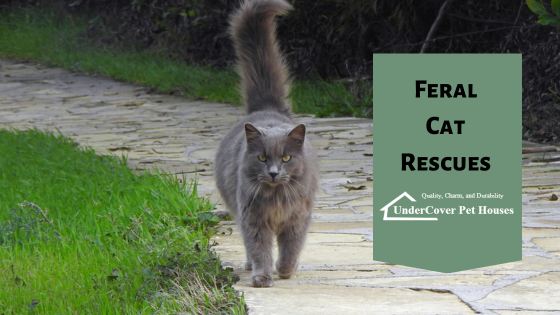 Loading... Please wait...
Loading... Please wait...Volunteering with a Feral Cat Rescue: What to Expect (Part 2)
Posted by Danny MacDonald on 2023 Aug 30th

Volunteering and being part of feral cat rescue is a rewarding endeavor that helps improve feral cats' lives and enriches your own life.
Part 1 covered the first three steps to perform a feral cat rescue. This is part 2 of a comprehensive guide where we're exploring the feral cat rescue process and insights, including what to expect and how to go about it. Please read part 1 here.
Now, let’s get into the remaining steps.
The Feral Cat Rescue Process: Step-by-Step Guide
Here's a step-by-step guide to achieving successful feral cat rescues using the Trap-Neuter-Return (TNR) method.
4. Monitoring and Trapping
Monitor the set traps closely, preferably from a distance, to avoid scaring the cats away.
Cover the trap once a cat is trapped to minimize stress and keep the cat calm.
5. Transport the Feral Cat to Veterinarian
Ship the trapped cat to a vet experienced in feral cat care. While on it, ensure the cat is handled carefully to minimize stress.
6. Spaying/Neutering and Medical Care
Seek advice from the vet to determine the cat's health.
The vet will address any medical issues the cat may have, such as vaccinations, treatment for injuries or illnesses, and spaying or neutering needs.
7. Recovery and Observation:
Allow the cat to recover in a quiet, warm, and secure environment. Monitor the cat closely during the recovery period to ensure no complications.
8. Ear Tipping and Identification:
As a standard practice in TNR, the tip of a cat’s ear is painlessly removed while the cat is under anaesthesia to indicate that the cat has been neutered and vaccinated.
9. Return to Colony
Once the feral cat has fully recovered, you can return it to its original location, where it is familiar with the environment and colony members.
You can place cat shelters, food, and water near the release point to help the cat re-adjust. Then, continue to provide food, water, and protection for the cat colony.
10. Community Engagement & Education
Educate your local community about the importance of TNR and responsible feral cat management. Share success stories and raise awareness about the benefits of feral cat rescue efforts.
Discover how to raise awareness about TNR programs, responsible pet ownership, and the overall welfare of feral cat populations.
Providing shelters for protection from the elements and working on socialization to help cats become more comfortable around humans. Some feral cats may eventually become adoptable, transitioning from a feral to a domesticated lifestyle with proper care and socialization.
Summary
Volunteering with a feral cat rescue organization involves compassion, commitment, and transformation. As you embark on this path, you’re now armed with insights into the rescue process to help you make a real difference in the lives of these furry creatures.
Remember, rescuing feral cats is not without its challenges. So, learning how to navigate setbacks such as resistant cats, health issues, and behavioral hurdles is crucial.
Put in some dedication, patience and collaboration with experienced individuals or organizations as you work to overcome any challenges.
Always prioritize the welfare of the cats and work within the guidelines of your local laws and regulations.
At www.undercoverpethouses.com -We sell the best OUTDOOR cat shelters. Your outside cat will love it!
